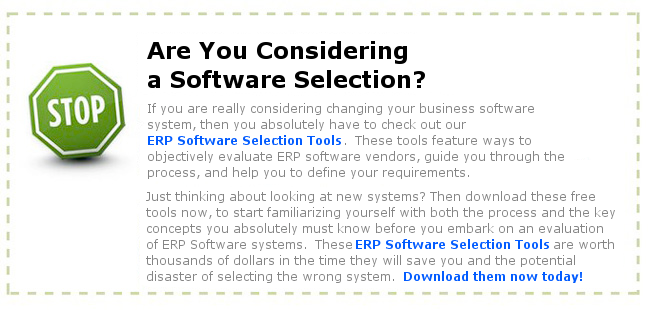A good number of ERP software implementations are focused around manufacturing. Although Manufacturing ERP is one of the more complex implementations, a company stands to have significant ROI gains due to improved management of inventory and work-in-process.
The following article touches on some of the points to consider when implementing for a manufacturing firm. It points to one solution at the summary. This is not the best way to go (ie. looking at a specific target software), you need to focus on the software solutions that best satisfy your requirements. Requirements first, software second.
Your One Stop Guide To Manufacturing Accounting Software
Ashish Jain
Manufacturing in simple terms means changing of raw materials into final goods, ready for selling. Different processing methods and equipments are used in this transformation. So, how do you manage all these processes?
Definitely, you can take the help of a manufacturing accounting software. Manufacturing Accounting Software is developed with a view to achieve the various financial needs related to production. It is full of various functional modules assigned for different tasks. Accounts payable, accounts receivable, general ledger and much more are the essential modules of an efficient manufacturing software.
No matter what your business is, no matter whether it is big or small, you are bound to face some of the critical business challenges. Some of the basic challenges of a business related to manufacturing like constant optimization of inventories, processing and fulfilling of customer orders in a timely manner have to be tackled in an efficient way while keeping a firm grasp on the financial aspects of the company.
And here the great role of manufacturing accounting software comes into picture and enables you to face the challenges of your business set up. To define manufacturing software, it is an application used in the management and inventory field. Management and control of any organization has never been so easy.
A manufacturing software enables you to handle everything associated with production very easily. Management of manufacturing involves four main steps- estimating, producing, accounting and reviewing. And, with manufacturing software, all these become very easy. A manufacturing software is very helpful in entering different plans electronically and monitoring their process regularly. It also helps in tracking the assets of a company which is a crucial part.
Manufacturing software is great in the sense that it can easily link the product demand with the production ability of a company. It helps in the optimization of resource usage. It is great in forecasting future trends as well. Features such as sales forecasting, contact management, analysis and alike help in the effective management of the organization.
There are several manufacturing accounting software which you will find beneficial to your particular industry. Some of the manufacturing software solutions have developed manufacturing- specific solutions for different product lines. Manufacturing business requires that when the demand hits, it must be able to deliver. This software provides you the required tools to keep production running smoothly and efficiently, including powerful inventory management tools, job costing tools and much more.
One such excellent manufacturing accounting software is developed by Sage software to meet the unique accounting needs of the manufacturers. The name of the software is Peachtree Premium Accounting for Manufacturing. It encompasses key data and tools to assist you in fulfilling important jobs, quickly and easily. Other features of the software are manufacturing guide, pre-built reports, work tickets and quantity price breaks giving accurate inventory control and making you aware of the operational insight into your production and assembly processes. Above all, starting up and learning this software is very easy.
The software supports core accounting features and reporting options. It helps you in keeping track of:
a) Accounts Receivable
b) Time, Billing and Job Costing
c) General Ledger
d) Inventory
e) Accounts Payable
f) Payroll Solutions
g) Fixed Assets
Peachtree Premium Accounting software thus makes it possible for you to conquer the challenges of operating a profitable manufacturing business. It gives you a powerful yet flexible tool, designed specifically to help you meet challenges of your manufacturing operations. This software is known for its sound inventory and assembly management features. All these make this software, the choice of millions of small businesses. I strongly recommend you this software for at least once in your business. And I’m sure that you will be hooked.
Ashish Jain
To get more information about accounting, accounting software and types of acconting software visit http://www.managemyaccounting.com/
